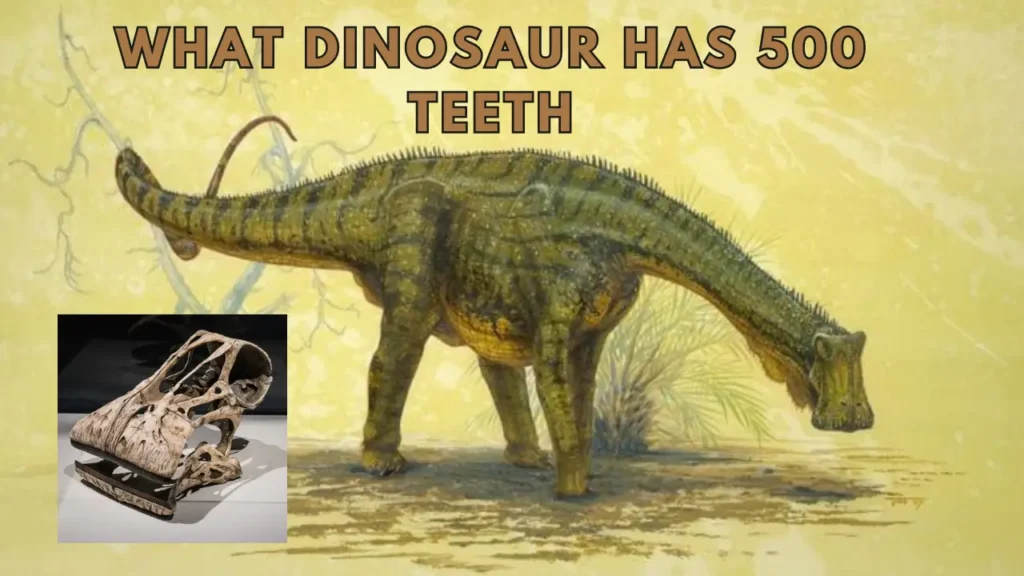
What Dinosaur Has 500 Teeth, Dinosaurs have always fascinated people with their huge sizes, varied shapes, and mysterious lives.
Among the many known dinosaurs, one that stands out due to its unusual feature is the Nigersaurus. If you’ve ever wondered, “What dinosaur has 500 teeth?”, the answer is the Nigersaurus.
This dinosaur is known not just for its impressive number of teeth but also for its unique feeding habits and anatomy. This article will explore everything you need to know about the Nigersaurus, including its appearance, diet, habitat, and more.
What Is the Nigersaurus?
The Nigersaurus is a dinosaur that lived about 110 million years ago during the middle of the Cretaceous period. It was first discovered in the Sahara Desert in Niger, Africa, which is how it got its name.
The Nigersaurus belonged to a group of dinosaurs known as sauropods, which are characterized by their long necks and tails, small heads, and massive bodies.
However, the Nigersaurus was different from other sauropods because of its wide mouth and an incredible number of teeth—500 to be exact. The Nigersaurus was relatively small for a sauropod, measuring about 30 feet long, which is about the size of a modern elephant.
Why Does What Dinosaur Has 500 Teeth?
One of the most remarkable things about the Nigersaurus is its 500 teeth. But why did this dinosaur need so many teeth? The answer lies in its diet. The Nigersaurus was a herbivore, meaning it ate plants.
Its 500 teeth were specially designed to help it graze on vegetation close to the ground. The teeth were arranged in rows and constantly replaced, with new teeth growing in every 14 days.
This rapid tooth replacement was necessary because the Nigersaurus used its teeth heavily to strip leaves and plants, which would wear them down quickly. The wide, flat shape of its mouth made it perfect for grazing, almost like a prehistoric lawnmower.
What Did the Nigersaurus Eat?
The Nigersaurus primarily fed on plants, but what kind of plants did it eat? Because of its wide mouth and the way its teeth were arranged, the Nigersaurus likely fed on soft plants such as ferns, horsetails, and other low-lying vegetation.
It probably did not eat tough, woody plants because its teeth were not strong enough for such a diet. Instead, it preferred soft leaves and plants that grew close to the ground.
The Nigersaurus used its wide snout to scoop up large amounts of plants quickly, making it a very efficient feeder.
How Did the Nigersaurus Look?
The Nigersaurus had a very distinctive appearance. Its most notable feature was its large mouth filled with 500 teeth. Its head was short and wide, with a long neck that helped it reach vegetation.
Unlike other sauropods, the Nigersaurus had a relatively light build. Its body was not as massive, and it had a shorter neck compared to giants like the Brachiosaurus. It also had a long tail, which helped it balance.
The Nigersaurus had a unique skull that was highly specialized for its feeding habits, with openings on the side to reduce weight and support its heavy jaw.
Where Did the Nigersaurus Live?
The Nigersaurus lived in what is now the Sahara Desert, but during its time, this area was much different. Around 110 million years ago, the region was a lush, green environment with rivers, forests, and a wide variety of plant life.
This environment provided the Nigersaurus with the perfect habitat for grazing. Fossil https://www.fossil.com/en-us/evidence suggests that the Nigersaurus lived alongside other herbivores as well as predators like the Suchomimus. Its habitat was rich in vegetation, which supported its grazing lifestyle.
How Was the Nigersaurus Discovered?
The Nigersaurus was discovered by French paleontologist Philippe Taquet in the 1960s, but it wasn’t until the late 1990s and early 2000s that more complete remains were found.
Paul Sereno, an American paleontologist, led an expedition to the Sahara Desert and uncovered more fossils of the Nigersaurus, which provided a clearer picture of what this dinosaur looked like and how it lived.
The fossils found included parts of the skull, teeth, and bones, allowing scientists to understand more about its feeding habits and lifestyle.
What Makes the Nigersaurus Unique?
The Nigersaurus stands out among dinosaurs because of its 500 teeth and the way it used them. Unlike many other dinosaurs, which had teeth suited for biting or chewing, the Nigersaurus had teeth that were constantly replaced and perfectly suited for grazing on plants.
Its skull was also unique, with openings that made it lighter and allowed it to support its wide mouth and many teeth. The Nigersaurus is often referred to as a “Mesozoic cow” because of its grazing habits, which were very different from other sauropods.
Pros and Cons of the Nigersaurus’s Teeth
| Pros | Cons |
|---|---|
| Allowed efficient grazing on plants | Teeth wore down quickly due to heavy use |
| Rapid tooth replacement every 14 days | Not suitable for eating tough, woody plants |
| Wide mouth enabled large bites | Limited to feeding on low-lying vegetation |
How Did the Nigersaurus Fit Into Its Ecosystem?
The Nigersaurus played an important role in its ecosystem by helping to control the plant population. By grazing on a wide variety of plants, it helped maintain the balance of vegetation in its environment.
This not only provided food for itself but also affected the habitats of other animals. The Nigersaurus likely traveled in herds, which could have helped protect it from predators.
Its role as a grazer meant that it was a key part of the food chain, supporting both plant and animal life in its ecosystem.
Why Is the Nigersaurus Important Today?
Learning about the Nigersaurus helps us understand more about the diversity of life that existed millions of years ago. It shows us that dinosaurs were not all the same; they had a variety of shapes, sizes, and feeding habits.
The Nigersaurus, with its 500 teeth, is a perfect example of how animals adapt to their environment to survive. Studying dinosaurs like the Nigersaurus also helps scientists learn more about how ecosystems change over time and how animals evolve to fit their surroundings.
Conclusion
The Nigersaurus is a fascinating dinosaur that answers the question, “What dinosaur has 500 teeth?” With its unique feeding habits, large number of teeth, and special adaptations, the Nigersaurus stands out among the many dinosaurs that once roamed the Earth.
Understanding the Nigersaurus gives us insight into the incredible diversity of dinosaur life and the ways in which these ancient animals adapted to their environments. As we continue to study dinosaurs like the Nigersaurus, we learn more about the past and how it shapes the world we live in today.


